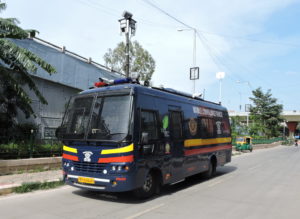Video Analytics uses mathematical algorithms to monitor, analyze and manage large volumes of video. It digitally analyzes video inputs; transforming them into intelligent data which help in taking decisions.
Video Analytics can be real-time – configured to track and provide alerts to specific incidents as they happen – or post event – retrospectively searching for incidents that have already occurred.
Video Analytics Architecture
Video analytics applications can run at the centre (on servers or DVRs at the central monitoring station), at the ‘edge’ (built into cameras) or as a combination of both.
The ‘edge’ solutions are ideal to locate live analytics. Central real-time processing can run out of steam based on the no. of cameras in the network, processing power and the network bandwidth; whereas in the ‘edge’ solution, every camera has dedicated processing. Customers with limited bandwidth on their networks can opt for an analytics solution at the ‘edge’, so that only information on suspicious incidents gets sent through the network; and hence, doesn’t use up network bandwidth.
The optimal place to locate post-processing analytics is obviously on a central server, so that recorded video can be searched many times, with different parameters. Using analytics a user can search large amounts of recorded video for possible events and then verify the results. End user companies with existing infrastructure, who want to upgrade by adding analytics to some of their existing cameras, may find integrating analytics to the central server a cost-effective and flexible solution.
Applications
Video surveillance analytics are finding numerous applications in both the public and private sectors; in government, retail, transport and financial services. These applications protect people and assets against harm and damage, ideally before events occur. Systems enabled with video analytics work on two key concepts: motion detection and pattern recognition.
Motion Detection: By examining each pixel in the frame, the video analytics software is able to pick up even the slightest movement.
Pattern Recognition: Video analytics help distinguish objects within a video frame. Specific patterns/objects can be programmed, which will be recognized within the frame. Should any change happen, i.e. object is moved, goes missing, or new object added; the software immediately recognizes it and sends out an alert.
Typical applications of Video Analytics in security and surveillance include:
> License Plate Recognition
> Security Access Point Monitoring
> Perimeter Protection / Intrusion Detection
> Abandoned Object
> Object Removal
> Camera Tampering
Video analytics is also gaining popularity in the retail segment for market analysis. A lot of the analytics information can be valuable for marketing teams in companies. These include:
> Footfalls (People counting)
> Gender counting
> Display/shelf space effectiveness and
> Forensics analysis of data to determine trends
Benefits of Video Analytics
Controlling and managing a video surveillance system is difficult; especially if you are working with a large number of cameras. Keeping track of everything that is going on is a hassle and requires a lot of manpower.
This is not the case with video analytics. Video analytics use detailed and sophisticated algorithms to examine digital video feeds. Video images are examined pixel by pixel, missing absolutely nothing. Analytics filters can be intelligently tailored to meet specific security or business needs.
Some of the filters/algorithms that help in the above are:
> Direction filters with independent adjustment of acceptable direction and angle
> Dwell filter with variable time threshold.
> Speed filter with upper and lower speed thresholds
> Object filters to filter out birds, small animals, blowing trash and other such clutter
Limitations of Video Analytics
While video analytics holds great promise, the jury is still out on the efficacy of the technology in the real world. The key thing to note here is that video analytics technology is still in its infancy.
Current video analytics solutions do work, but in a constrained environment. For example, video analytics if used for perimeter security or vehicle license plate recognition or unattended baggage in a public space, will work; provided weather conditions are not extreme, the number of vehicles is not very high, or in an not so crowed location, respectively. On the other hand, if a user wishes to identify unattended baggage in a busy railway station at peak hours, he will surely be disappointed; as the system will end up generating too many false alerts.
Thus, keep in mind that the success of a video analytics implementation will be determined by the use it is put to and in situ conditions.



